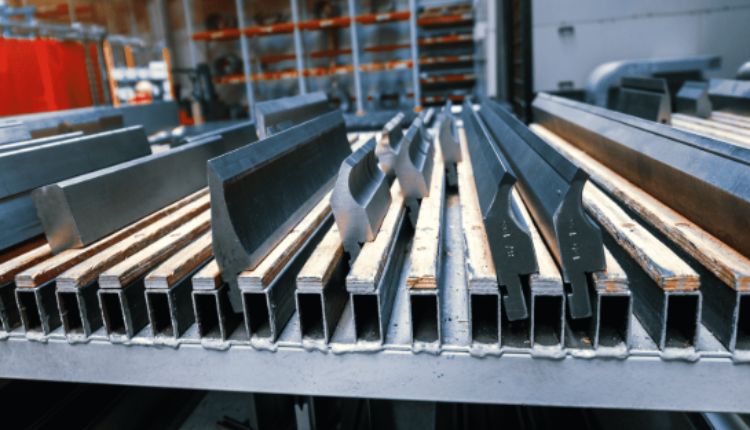Press brake dies are the tools that shape metal in a press brake machine. They work with the punch to bend sheet metal into specific angles or forms. If you’re in metal fabrication, picking the right die is a big deal—it affects your project’s accuracy, speed, and cost. There are several types of press brake dies out there, and each has its own strengths. In this article, we’ll break down the most common types, explain what they’re good for, and help you figure out which one fits your needs. Let’s dive in.
What Are Press Brake Dies?
First, let’s get clear on what press brake dies are. A press brake die is a metal tool that sits below the sheet metal in a press brake machine. The punch presses the metal into the die, and that’s how you get your bend. Dies come in different shapes and sizes, depending on the job. They’re usually made from tough materials like hardened steel to handle the pressure and wear.
The die you choose depends on a few things: the metal type, its thickness, the bend angle, and how precise you need to be. Picking the wrong die can mess up your workpiece or slow you down. So, knowing the options is key.
Common Types of Press Brake Dies
Here’s a rundown of the main types of press brake dies you’ll come across. Each one has a specific purpose, and we’ll explain them step by step.
V-Dies
V-dies are the most popular type out there. They have a V-shaped groove where the metal gets pressed. The size of the V (called the opening width) and the angle determine the bend. For example, a common V-die might have a 90-degree angle and an opening 6 to 8 times the metal thickness. So, for a 1 mm thick sheet, you’d want a 6-8 mm wide V-die.
V-dies are great for general bending tasks. They’re versatile and work well with different metal thicknesses—usually up to 10 mm, depending on the machine’s tonnage. If you’re doing simple 90-degree bends on steel or aluminum, this is often your go-to.
U-Dies
U-dies have a U-shaped channel instead of a V. They’re used for making wider, shallower bends, like trays or boxes with rounded edges. The U shape gives the metal more room to form without sharp angles. These dies are less common than V-dies but handy for specific jobs.
For instance, if you’re working with 2 mm steel and need a smooth curve, a U-die with a 20 mm opening might do the trick. They’re not as precise as V-dies for tight angles, but they shine in projects needing a softer bend.
Z-Dies
Z-dies are for making Z-shaped bends—think of steps or offsets in the metal. They have a stepped design that lets you bend the metal in two directions in one go. This saves time if you’re making parts like brackets or frames.
Z-dies are trickier to set up and usually work best with thinner metals, like 1-3 mm sheets. They’re not as flexible as V-dies, but for Z-shaped parts, they’re unbeatable.
Acute Angle Dies
Acute angle dies are built for bends less than 90 degrees—say, 30 or 45 degrees. They have a narrower V shape with sharper angles. These are perfect for projects needing tight, precise bends, like small components in electronics or machinery.
A typical acute die might have a 30-degree V and a 4 mm opening for 0.5 mm thick metal. They’re less common for heavy-duty jobs because they can’t handle thick materials as well—usually topping out at 6 mm.
4 Way Press Brake Die
The 4 way press brake die is a special type with four different V openings on one tool—usually something like 6 mm, 8 mm, 10 mm, and 12 mm. You rotate it to use the size you need. This makes it super convenient if you’re switching between metal thicknesses a lot.
It’s a time-saver for shops doing varied jobs. For example, you could bend 1 mm steel with the 6 mm side, then flip it to the 12 mm side for 2 mm steel—all without swapping tools. It’s not as cheap as a single V-die, but the flexibility pays off.
Factors to Consider When Choosing a Die
Now that you know the types, how do you pick the right one? Here are the main things to think about.
Material Thickness
The thickness of your metal is a big factor. V-dies follow a rule: the opening should be 6-8 times the metal thickness for standard bends. So, a 2 mm sheet needs a 12-16 mm V-die. Thicker metals (over 10 mm) might need custom dies or higher tonnage machines. U-dies and Z-dies work better with thinner sheets, usually under 5 mm.
Bend Angle
What angle are you aiming for? V-dies handle 90-degree bends easily, while acute dies are for sharper angles. Z-dies are for stepped bends, and U-dies suit wider curves. Match the die to your angle needs.
Production Volume
If you’re doing small batches, a simple V-die or 4 way press brake die might be enough. For high-volume runs, precision matters more—acute dies or CNC-compatible dies could be worth it. The more consistent the die, the less tweaking you’ll need.
Machine Tonnage
Your press brake’s power limits your die choice. A 100-ton machine can handle a 10 mm thick steel sheet with a wide V-die, but a 50-ton machine might struggle. Check your machine’s specs—most manufacturers list tonnage charts for dies.
Pros and Cons of Each Type
Let’s sum up the good and bad of each die type.
- V-Dies: Pros—versatile, affordable, widely available. Cons—limited to standard angles, not great for complex shapes.
- U-Dies: Pros—good for wide bends, simple setup. Cons—less precise, not for tight angles.
- Z-Dies: Pros—fast for Z bends, saves steps. Cons—niche use, harder to adjust.
- Acute Angle Dies: Pros—sharp, precise bends. Cons—less durable with thick metals, higher cost.
- 4 Way Press Brake Die: Pros—multi-size options, efficient. Cons—pricier, bulkier to handle.
Real-World Applications
Where do these dies show up? V-dies are everywhere—think steel frames or car parts. U-dies pop up in trays or enclosures. Z-dies make brackets for construction. Acute dies are big in electronics for tiny, exact bends. The 4 way press brake die fits small shops juggling different jobs daily.
How to Get Started
Ready to pick a die? Start by checking your project: what’s the metal, thickness, and angle? Then, match it to your press brake’s power. If you’re new, a standard V-die is a safe bet—cheap and easy to use. For more options, browse places like https://miharmle-cnc.com/ to see what’s out there.
Test your setup too. Run a sample bend to make sure the die fits your machine and material. Adjust the tonnage if the bend’s off—about 80% of issues come from mismatched settings, per industry stats.
Wrapping Up
Press brake dies aren’t one-size-fits-all. V-dies cover most jobs, U-dies handle curves, Z-dies do steps, acute dies nail sharp angles, and the 4 way press brake die gives you options in one tool. Think about your metal, angle, and volume to pick the right one. A good die saves time and money—so choose wisely, and you’ll see the difference in your work.






